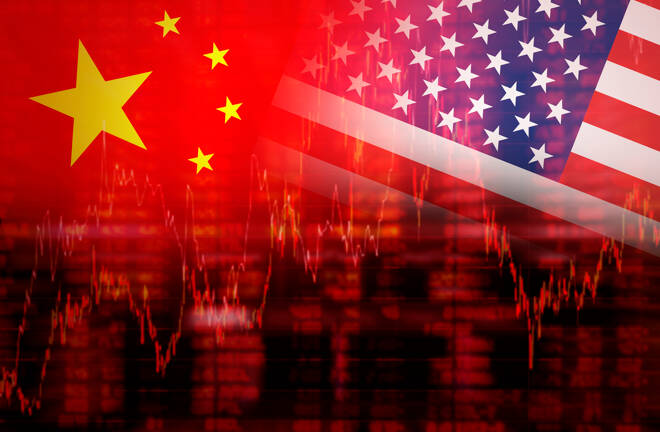Advertisement
Advertisement
US-China Trade Tensions Flare Anew on Tariff Talk News and Cancelled Pork Orders
By:
Key Points:
- Trump’s tariff flip-flop and Beijing’s denial of talks have fueled fresh US-China trade war tensions.
- China’s pain tolerance is reportedly higher than America’s, giving Beijing leverage in trade talks.
- Beijing pledges new stimulus measures, including RRR cuts, to counter tariff pressures and support growth.
Tariff Tensions Reignite as Beijing Rejects Trump’s Claims
Last week, President Trump flip-flopped on his tariff stance toward China, signaling a potential halving of levies to woo Beijing into trade negotiations. However, confusion quickly followed over whether Washington and Beijing had resumed trade talks. While Trump declared trade negotiations had resumed, Beijing categorically dismissed the claim. On April 28, China’s Foreign Minister reportedly stated:
“Xi, Trump did not have call recently. US, China have not conducted negotiations, consultations on tariffs.”
China’s outright rejection of Trump’s assertions appeared to intensify US-China tensions. Trump poured cold water on hopes of immediate tariff cuts, reportedly stating he would not remove tariffs unless China ‘give us something.’
Beijing responded by canceling US pork shipments, targeting a key constituency of the US President. The Kobeissi Letter reported:
“China cancelled shipments of ~12,000 metric tons of US pork last week, the most since the 2020 pandemic, when global supply chains were halted. As a result, overall US pork export sales dropped to their lowest level since October, according to Bloomberg. This comes as American pork imports to China now face a massive 172% tariff. This includes the duties first imposed during the 2018 trade war. Tariffs are hitting American meat exports.”
Can China Absorb Tariff Shocks at the Expense of the US Economy?
Beijing’s stance on tariffs suggests the US economy may ultimately suffer more, potentially giving China an upper hand in trade negotiations. Chief Emerging Markets and China Strategist at BCA Research Arthur Budaghyan offered insights into China’s position:
“China’s pain tolerance from the trade war is presently higher than that of the US. President Xi has been preparing the nation for a struggle for several years. The Chinese society is rallying around the flag. It is ready to endure some economic pain due to the trade war. American households, businesses, and investors are not ready to tolerate the pain due to the trade war.”
Budaghyan concluded that, as a result, Trump is eager to conclude a deal with China. Beijing, recognizing this urgency, may continue to drag its feet to secure a more favorable outcome.
China Policies vs. Fed Status Quo
Investors expect the US-China trade war to impact both economies. However, Beijing’s option to roll out fresh stimulus measures continues to ease fears of a sharp economic slowdown.
On April 28, China’s lawmakers held a press conference on the economy and announced stimulus pledges. According to CN Wire:
- Confident in achieving full-year economic growth target of around 5%.
- New policies will be introduced in Q2.
- Unveil new policies based on changes in the economic situation.
- PBoC will cut the Reserve Requirement Ratio (RRR) and interest rates when appropriate.
- Continue implementing appropriate loose monetary policy and step up support for the economy.
In contrast, Fed Chair Powell raised concerns about the impact of tariffs on the US economy and prices. Higher prices could delay Fed rate cuts, fueling fears of a US recession. Betting platform Kalshi puts the odds of a 2025 US recession at 57%, well above the 18% chance recorded on Trump’s Inauguration Day.
US-China Markets Divergence Grows
Mainland Chinese equity markets trended lower on Tuesday, April 29, though losses remained modest amid optimism about Beijing’s latest communications. The CSI 300 and Shanghai Composite Index slipped 0.14% and 0.04%, respectively. In contrast, the Nasdaq Composite Index ended a four-day winning streak on April 28, falling 0.10%.
Despite recent volatility, Chinese indices have outperformed US counterparts year-to-date (YTD). The CSI 300 is down 4.03% compared to a 10.07% drop for the Nasdaq Composite Index. Meanwhile, the Hang Seng Index has risen 9.8% year-to-date, highlighting the growing divergence.
Outlook
US-China trade developments remain pivotal for risk sentiment. News of resumed trade talks could calm investor jitters. However, stalled talks may trigger a broader market sell-off. Despite downside risks, fresh stimulus measures from Beijing could help mitigate tariff risks, potentially cushioning Mainland China and Hong Kong equity markets.
Currency movements will also warrant focus. A sharp devaluation of the Yuan could signal a significant escalation in the trade conflict. This week, Beijing pledged to maintain Yuan stability. YTD, the USD/CNY pair is down 0.36%, trading at $7.2725, below its April high of $7.3504.
Follow our ongoing coverage for the latest updates on China’s economic outlook, tariff developments, and global market trends.
About the Author
Bob Masonauthor
With over 28 years of experience in the financial industry, Bob has worked with various global rating agencies and multinational banks. Currently he is covering currencies, commodities, alternative asset classes and global equities, focusing mostly on European and Asian markets.
Did you find this article useful?
Latest news and analysis
Advertisement
